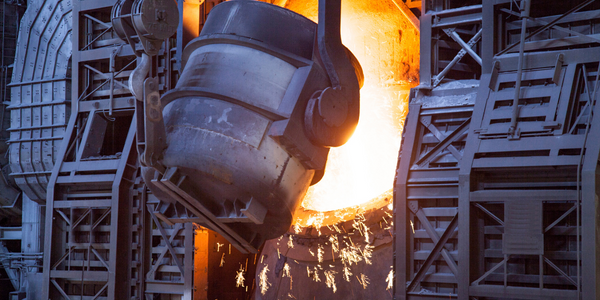Download PDF
QlikView moves business analysis from IT queue to timely decision making for USS-POSCO
Technology Category
- Analytics & Modeling - Real Time Analytics
Applicable Industries
- Metals
Applicable Functions
- Business Operation
- Sales & Marketing
Use Cases
- Predictive Maintenance
- Inventory Management
Services
- Software Design & Engineering Services
The Challenge
USS-POSCO was facing challenges in streamlining data reporting to improve decision-making speed and responsiveness to trends or problems. The company was heavily reliant on its overburdened IT staff for generating detailed data reports. The goal was to reduce the amount of time it took to answer business questions and move business analysis closer to end users. The company was looking for a solution that could quickly build a sound business intelligence system without heavy financial, time, or resource investment.
About The Customer
The USS-POSCO steel finishing plant in Pittsburg, California is owned and operated by USS-POSCO Industries (UPI), a joint venture company established by U. S. Steel Corporation and POSCO of the Republic of Korea. The plant manufactures cold rolled, galvanized and tin mill products from hot rolled steel, and ships its finished steel daily to more than 150 customers in the western United States. Several modernization programs, representing some of the largest investments in manufacturing facilities in California, have made USS-POSCO one of the most efficient and technically advanced steel finishing facilities in the world.
The Solution
USS-POSCO deployed QlikView to 40 employees across five functional areas. The company now analyzes hundreds of data points in multiple dimensions to improve the efficiency and effectiveness of its entire operation – from inventory management and fulfillment to supplier management and international trade. With QlikView Server (64-bit) and QlikView Publisher, USS-POSCO also easily supports security and visibility while handling a large data volume. QlikView moved a significant amount of report development out of USSPOSCO’s IT group into the business units, where end users know what data they need and how they want to use it.
Operational Impact
Related Case Studies.

Case Study
Goldcorp: Internet of Things Enables the Mine of the Future
Goldcorp is committed to responsible mining practices and maintaining maximum safety for its workers. At the same time, the firm is constantly exploring ways to improve the efficiency of its operations, extend the life of its assets, and control costs. Goldcorp needed technology that can maximize production efficiency by tracking all mining operations, keep employees safe with remote operations and monitoring of hazardous work areas and control production costs through better asset and site management.

Case Study
KSP Steel Decentralized Control Room
While on-site in Pavlodar, Kazakhstan, the DAQRI team of Business Development and Solutions Architecture personnel worked closely with KSP Steel’s production leadership to understand the steel production process, operational challenges, and worker pain points.

Case Study
Bluescope Steel on Path to Digitally Transform Operations and IT
Increasing competition and fluctuations in the construction market prompted BlueScope Steel to look toward digital transformation of its four businesses, including modern core applications and IT infrastructure. BlueScope needed to modernize its infrastructure and adopt new technologies to improve operations and supply chain efficiency while maintaining and updating an aging application portfolio.

Case Study
RobotStudio Case Study: Benteler Automobiltechnik
Benteler has a small pipe business area for which they produce fuel lines and coolant lines made of aluminum for Porsche and other car manufacturers. One of the problems in production was that when Benteler added new products, production had too much downtime.

Case Study
Continuous Casting Machines in a Steel Factory
With a very broad range of applications, steel is an important material and has been developed into the most extensive alloy in the engineering world. Since delivering high quality is absolutely crucial for steel plants, ensuring maximum productivity and the best quality production are the keys to competitiveness in the steel industry. Additionally, working conditions in steel factories are not suitable for workers to stay in for long periods of time, so manufactures usually adopt various machines to complete the steel production processes. However, the precision of these machines is often overestimated and the lack of flexibility also makes supervisors unable to adjust operating procedures. A renowned steel factory in Asia planned to improve its Distributed Control System (DCS) of furnaces as well as addressing the problem of insufficient accuracy. However, most well-known international equipment suppliers can not provide a satisfactory solution and local maintenance because the project needed new technologies to more accurately control equipment operations. By implementing Advantech’s automated monitoring and control solution, steel factories can not only improve the manufacturing processes but can also allow users to add additional functions to the existing system so as to make sure the operation runs at high efficiency.

Case Study
Automated Predicitive Analytics For Steel/Metals Industry
Asset to be monitored: Wire Compactor that produces Steel RebarCustomer Faced The Following Challenges:Dependent upon machine uptime.Pressure cylinders within the compactor fail to control compression and speed causing problems in binding the coil.Equipment failure occurs in the final stage of production causing the entire line to stop, can you say bottleneck?Critical asset unequipped with sensors to produce data.





